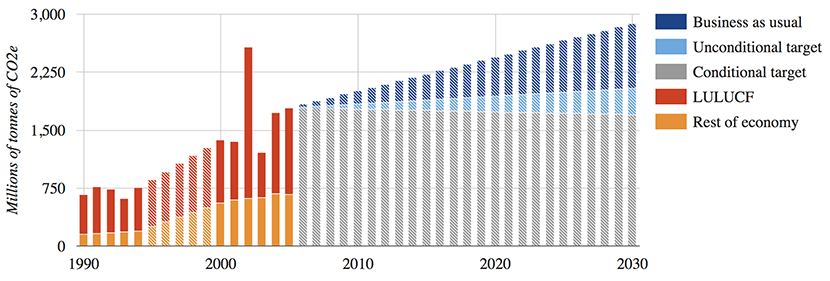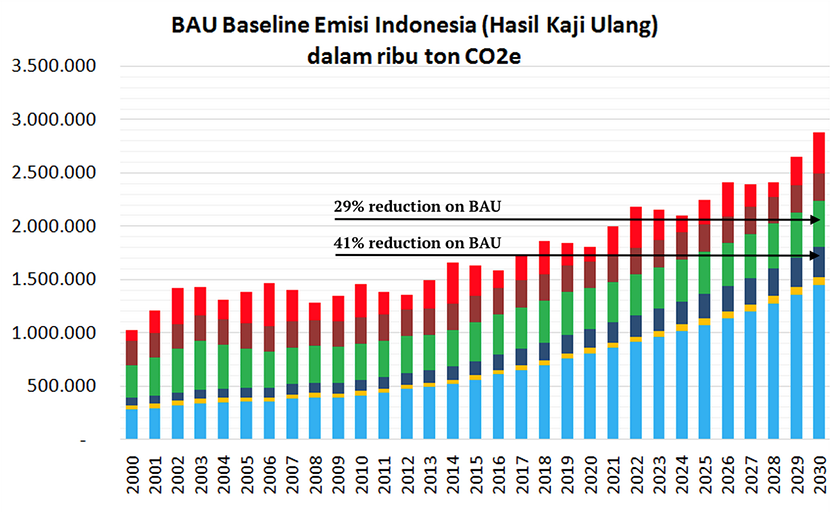Indonesian pledge suggests no increase in emissions to 2030
Simon Evans
09.25.15Simon Evans
25.09.2015 | 1:30pmIndonesia would not increase its emissions over the next 15 years if it receives international support, according to Carbon Brief analysis of its climate pledge to the UN.
Its intended nationally determined contribution (INDC) pledges a 29-41% reduction in emissions by 2030, compared to business as usual. The upper end of this range, conditional on “support from international cooperation”, would see emissions in 2030 remain at recently reported levels.
Indonesia’s pledge is significant. It is ranked in the top 10 and possibly even the top five emitting nations. However, there is wide uncertainty over its emissions, which are dominated by variable deforestation and fires. Carbon Brief has run the numbers on the pledge to gauge what it means.
No finance request
Indonesia’s INDC says it aims to decarbonise its economy “in a phased approach”. This pathway will be incorporated in its national development plan for 2019-2024, it says. The INDC extends an existing pledge to cut emissions by 26% against business-as-usual (BAU) emissions in 2020.
The INDC says the 2030 emissions targets will be met through:
“Improved land use and spatial planning, energy conservation and the promotion of clean and renewable energy sources, and improved waste management”.
It adds that inefficient energy use has been encouraged by fossil fuel subsidies, which President Widodo has started to reduce. However, the INDC lacks specifics on the policy priorities it sets out.
Unlike a draft, the final INDC also omits a request for $6bn of international climate finance to fund its 41% conditional pledge. This figure had been reported by the Guardian.
Andhyta Utami, researcher with World Resources Institute (WRI) Indonesia, tells Carbon Brief it is not clear why the finance request had been omitted. However, the figure had caused confusion, Utami says, because it clearly excluded much higher investment needs towards a pledge to source 23% of Indonesia’s energy from renewables by 2025.
A separate government document costs the renewables target at $108bn, she adds. Utami says:
“Indonesia could be more transparent on how much international assistance it will need to reach its conditional target…It should publish its financing needs before Paris.”
Utami also expressed concern over the make-up of the 23% goal, which represents a significant and ambitious leap compared to renewables’ current 4% share of the country’s energy mix. Bioenergy, including biofuels and biomass from crops such as palm oil, are slated to make up 10% of Indonesia’s energy mix in 2025, potentially putting pressure on already-threatened forest lands.
The WRI argues that solar, hydro and ocean energy should make up the majority of the renewables target instead. This would ease the pressure on land, which the government also expects to make Indonesia self-sufficient in food.
Alongside growing renewables, Indonesia has major plans to expand its coal-fired electricity generation, with coal use in the country already having doubled in a decade. This expansion is rapidly increasing emissions and will squeeze the country’s ability to stick to its climate pledge.
Coal expansion could “undermine” Indonesia’s efforts on renewables, WRI says. Coal is not mentioned in Indonesia’s INDC.
Uncertain emissions
As well as being hazy on policy and financing needs, it is also difficult to gauge the ambition of Indonesia’s INDC emissions targets. This is despite the document including a projected figure for BAU emissions in 2030 of 2.9bn tonnes of CO2 equivalent (GtCO2e).
The pledge to reduce emissions by at least 29% compared to this trajectory means an effective cap in 2030 of 2GtCO2e. With the more ambitious 41% reduction compared to BAU, the cap would be 1.7GtCO2e. The UK’s emissions are 0.5GtCO2e and China’s around 12.5GtCO2e.
This apparently clear-cut picture for Indonesia’s climate pledge is misleading, however. Climate Action Tracker’s evaluation of Jakarta’s previous climate pledges says “the uncertainty of LULUCF [land use, land use change and forestry] emissions makes an evaluation difficult”.
More than half of Indonesia’s annual emissions come from deforestation and peatland fires. Some of these are naturally-occurring, but many more are started deliberately – and illegally – to clear and re-clear land for crops, such as palm oil.
This year – and in other dry years related to the El Niño Atlantic weather cycle – forest fires can run out of control, causing dangerous smogs across south-east Asia. These fires can causemulti-billion tonne spikes in Indonesia’s greenhouse gas emissions.
Yet these emissions are hard to measure, requiring estimates of the land area affected as well as the depth of peat soils that have burnt. Variation between different inventories gives a sense of the resulting uncertainty in Indonesia’s emissions.
The World Resources Institute (WRI) CAIT database puts 2012 emissions including LULUCF at 2GtCO2e, making Indonesia the world’s fifth largest emitter that year. Yet the EU’s EDGAR database puts emissions, again including LULUCF, at 0.8GtCO2e – less than half the CAIT figure.
There are also large discrepancies for 2005. Indonesia’s own national submission to the UNreports emissions of 1.8GtCO2e, while CAIT has 1.6GtCO2e and EDGAR 1.2GtCO2e.
In order to understand how ambitious the Indonesian climate pledge is, we need to know how the 2030 targets compare to current emissions. As we’ve seen, that’s far from straightforward.
The chart below is an attempt to gauge the situation. It draws on Indonesia’s first and second national communications to the UNFCCC that report emissions for 1990-1994 and 2000-2005. The emissions trajectories to 2030 reflect Indonesia’s INDC pledges and its projections of BAU.
Indonesia’s past emissions and its targets for 2030. Historical emissions, shown in red and orange, are from Indonesia’s two official submissions to the UN. The hatched bars show a linear trend for years without officially-reported emissions. This fails to show large LULUCF emissions in 1997, estimated at 0.8-2.7GtCO2e, which were caused by forest fires. The hatched grey and blue bars show linear paths to the 2030 BAU, conditional and unconditional targets. Chart by Carbon Brief.
The chart above suggests Indonesia’s 29% or 41% reductions against BAU emissions in 2030 would amount to preventing any increase on recent levels. However, given the uncertainty in year-to-year emissions from Indonesia, this is itself uncertain.
Carbon Brief has annotated an Indonesian government chart of BAU projections to 2030, showing the implications of the 29% or 41% pledges (chart below). Again, this suggests the more ambitious 41% reduction on BAU would see no increase in emissions over the next 15 years.
Modelled past and BAU future emissions in Indonesia. The arrows, added by Carbon Brief, mark 29 and 41% reductions on BAU in 2030. The variable green and red bars show modelled emissions from deforestation and forest fires on an assumed five-year cycle for El Niño. Source: Government of Indonesia.
The chart above highlights just how quickly Indonesia’s energy-related emissions (light blue bars) are expected to grow under BAU, with coal expansion a major contributor to that. Indonesia is also the world’s largest exporter of coal.
Conclusion
There are multiple uncertainties around Indonesia’s INDC. These include how much finance it wants from international donors, what its emissions are at the moment, how it has calculated its BAU trajectory and how it aims to reach its emissions targets against that trajectory.
As Reuters reports, “a lack of detail made it hard to judge the magnitude of Jakarta’s plan”. DrNirarta Samadhi, country director for WRI Indonesia, says the plan is “encouraging” and shows the government is serious about tackling climate change. But he adds that more transparency is needed to boost confidence in the scale of the country’s efforts.
Main image: Bromo volcano at sunrise,Tengger Semeru National Park, East Java, Indonesia. Credit: lkunl/Shutterstock.com.
-
Indonesia pledges a 29-41% reduction in emissions by 2030, compared to business as usual #INDC #COP21
-
Indonesia would not increase its emissions over the next 15 years if it receives international support #INDC #COP21
-
Indonesian pledge suggests no increase in emissions to 2030 #INDC #COP21




